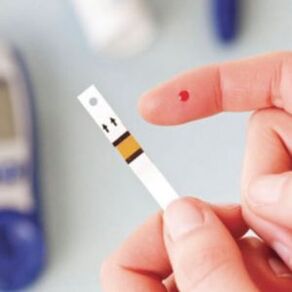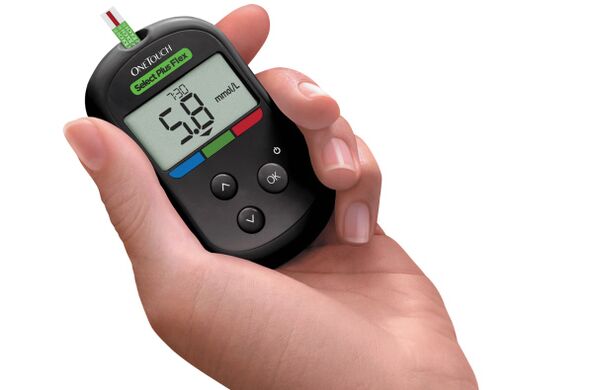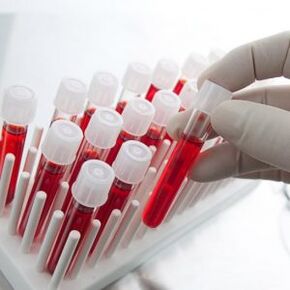
Symptoms of diabetes are a set of specific clinical manifestations for a particular disease that indicates the occurrence or progression of the pathological process for doctors and patients.
Diabetes mellitus is recognized as one of the most common diseases in the world, and nowadays 350 million people in the world have suffered. According to statistics, in just two decades, the number of cases has increased more than ten times. These people are approx. 90% - second type of diabetes.
If you identify the pathology in the initial stages, you can avoid a huge number of serious complications. Therefore, it is so important to know what indicates the onset of the disease and how to examine a person to regulate this severe endocrine pathology.
The manifestation of diabetes does not depend on the type. The human body is able to understand when sufficient levels of energy stops from the glucose needed in this case, to the results of metabolism, and remains a lot of bloodstream, causing enormous, irreversible damage to systems and organs. Different metabolism processes in the body are provided by lack of insulin, which is responsible for glucose metabolism. But the characteristics of the pathogenesis of first and second types of diabetes show significant differences, so they need to be accurately familiar with each of its symptoms.
The main symptoms
Lack of insulin in the blood or decrease in the sensitivity of insulin -dependent cells in the body leads to high glucose concentrations in the body. In addition to this symptom, which is considered to be the main diabetes, there are other symptoms that are observed in the patient's medical observation. If this disease has the slightest suspicion, it is worth seeking medical help, as the treatment of early detected illness and even school children in the modern world suffer from diabetes.
The first manifestations

As the first manifestation of diabetes, doctors call many specific symptoms. In diabetes, patients are always polyuria - rapid and abundant urination, glycemia and glucose in urine. Glucosuria is the cause of preventing the absorption of the fluid by kidney structures. Polyuria is always accompanied by a thirst in which a person can consume 10 liters of fluid a day.
Despite the consumption of so many fluids, there is a constant dry mouth. The second type of diabetes and thirst have a feeling of constant hunger. This is due to the fact that large amounts of insulin produced by the pancreas circulates in the blood and does not use the purpose of giving the brain signs of hunger.
High levels of glycemia cause severe damage to the body. Damage to nerve fibers leads to the occurrence of diabetic polyneuropathy. The first sign of such a complication is numbness of the fingers of the legs and hands and the severe pain of the limbs. If you start acting in the blood at the level of glucose in time, the development of this process can be stopped and the pain syndrome, if not at all, is disturbing, not as pronounced. However, if you fail to start the pathology progress, you can expect very serious consequences - severe pain, innervation, tropical ulcers and other things.
Damage to the high glycemia of the eye vessels develops diabetic angiopathy. From a clinical point of view, the disease is initially illustrated in the blood with high glucose concentrations, followed by a reduction in visual acuity and a decrease in total blindness in the absence of therapy. The patient should be forced to examine the patient to detect insulin insufficiency urgently.
External manifestations
There are also external signs that indicate the occurrence of insulin resistance and high glycemia. For example, such a symptom can be a sharp development of dry skin, itching and peeling. It is especially important to pay attention to the manifestations of such skin in the background of concomitant thirst. In the case of diabetes, itching occurs very often on the mucosa mucosa due to the irritating effect of glucose in the urine. There is no discharge at the same time, which is a distinctive feature of diabetes.
In addition, sharp weight loss is a sign of the first type of diabetes. In this case, other symptoms of the pathology should be observed so that they do not draw hasty conclusions. Obesity and excessive weight are not a symptom of second type of diabetes, but may be the cause. In any case, if the weight of a person changes in any direction for no obvious reason, it is worth paying attention to this and going through a doctor's examination.
Symptoms of diabetes
The first type

The first type of diabetes is very rapid. It has its own specific manifestations that you have to pay.
The patient has an increased appetite in history, but only loses weight, exhausted, suffering from drowsiness. Frequent urges do not allow the toilet to sleep calmly and forced them to get up several times. In this case, the amount of urine increases significantly as the feeling of thirst progresses.
Such symptoms cannot be left unnoticed because it occurs very sharply and suddenly. This is accompanied by nausea, vomiting and severe irritability. It is especially important to pay attention to the constant urgency of the night toilet in children if it has not been observed before.
The main problem with the first type of diabetes is that glucose levels can also increase in the blood and may be very sudden. Both states are dangerous to health and have their own qualities and manifestations that need to be carefully checked.
The second type
The second type of diabetes is the most common. Its shows are very diverse, gradually appearing, so it is difficult to catch and recognize them immediately. Mild symptoms usually do not lead to the fact that a person who discovered it at home immediately begins the alarm.
The second type of diabetes is characterized by dry mouth, thirst, abundant urination, weight loss, fatigue, weakness and drowsiness. In the early stages of the disease, one of the features of the disease is the presence of tingling in the fingers and numbness of the limbs, hypertensive manifestations, and the occurrence of infectious processes in the urinary tract. Similarly, the first type of the patient's diabetes may be disrupted by nausea and vomiting, drying and itching of the skin, and skin infections.
It is important to note that the gradual development of symptoms leads to the development of the disease itself. In later stages, diabetes leads to hyperosmolar comlar, lactoacidosis, ketoacidosis, hypoglycemia, which receive momentum within hours and can lead to the patient's death. In addition, as a result of advanced diabetes, patients often have serious visual problems and later lead to complete blindness, kidney or heart failure, and the pathology of the vascular and nervous system.
During pregnancy

Diabetes pregnancy sugar is rarely manifested with some specific external symptoms. Most often, its presence is found in planned studies, which are regularly performed for pregnant women. The main indicators are data from blood and urine tests.
In the presence of external signs of pregnancy -type disease, each is very similar to the symptoms of the first two types of diabetes - nausea, vomiting, weakness, thirst, infection in the geniturinary system is not separately signs of toxicosis and other pathologies, and the second and third trimester of pregnancy indicates gestational sparkling events.
The pathology of the direct threat to the life of the mother or child does not carry the form of pregnancy, but this may affect the general course of pregnancy, the future mother's well and the fetus.
The high blood content of glucose leads to the birth of a high -weight (more than 4 kilograms) infant, which is a prerequisite for obesity or the occurrence of diabetes in the future. The delay in child development, hypoglycaemia, and jaundice is also reflected in the first pores of the newborn's life.
Signs of complications
Diabetic leg
The diabetic leg of medicine is considered anatomical and functional change in the tissues of distant parts of the lower limbs in diabetes. This is the most formidable complication of the examined pathology, often to gangrene, the amputation of the limbs and the disability.
If you have a history of diabetes in your leg health, you should be very careful. There are three main forms of diabetic legs: neuropathic (damage to dominant nerves), ischemic (dominant lesion of blood vessels and disorder between blood vessels), mixed.
Among the complaints of patients in the diabetic legs, professionals distinguish between discomfort, burning and sewing and sewing feelings of the legs, gooseboats, and current emptying feelings. If such symptoms disappear when walking, this indicates the beginning of the neuropathic form of diabetic foot. It is also important to pay attention if the sensitivity disappears regularly. If painful feelings arise directly when walking or at night (only from the edge of the bed by relaxing the limbs), this means that it is the beginning of the ischemic form of diabetic legs, the so -called "ischemic foot".
Among the signs of the onset of diabetic legs, experts distinguish the skin of the skin on the legs, or the occurrence of pigment spots, peeling and dry skin, incidenceLegs on the legs, between the mantles on the skin, between the cloaks, deformation of the edges on the legs, the skin, the skin, between the stones, the deformation of the edges, the deformation of the edges, the edges, the legs, the deformation of the legs, the legs of the legs. If you notice at least a few such signs, you need to seek medical attention urgently.
Signs of retinopathy
Diabetes ophthalmology in the retina is shown by changes in blood vessels, leading to a violation of microcirculation. Such an infringement leads to the occurrence of diabetic retinopathy. Such a complication is gradually evolving, and even in later stages it can be almost invisible to a person.
The main signs of diabetic retinopathy are as follows:
- the appearance of "flies" in mind;
- blurred vision;
- decrease in visual acuity in later stages;
- Bleeding in the glass body and retina.
In this case, there are two main forms of diabetic ophthalmology - no -fiber (background) or retina proliferation retina retina. Background -tinopathy, pathological concerns, above all, the retina itself. In the case of violation of the retina capillary vessels, bleeding, retina swelling and metabolic products occur. Background -tinopathy is typical of elderly patients with diabetes. Provokes a gradual decrease in visual acuity.
Based on the background, proliferation retinopathy develops when the OSIGAL support deficit is increased. In this case, there is a pathological formation of the new blood vessels, which is converted to a glass body from the retina. This process leads to the bleeding of a glassy body and the sharp progress of vision vision in a person and irreversible blindness. In adolescence, within a few months, such a complication may occur from one form to another, then the retina detachment and the total loss of vision occur.
Encephalopathy signs

Diabetic encephalopathy occurs as a complication of diabetes due to diffuse degenerative damage to the brain. The prevalence of encephalopathy depends directly on the type and symptoms of diabetes - the duration and severity of the disease. It belongs to late complications and is manifested 10-15 years after the manifestation of diabetes.
The direct cause of the development of encephalopathy is the metabolic disorders of diabetes that lead to damage to the brain tissue and blood vessels. The above processes lead to a violation of cerebral activity, a reduction in cognitive functions. The development of encephalopathy occurs very slowly, leading to difficulty in the early symptoms.
The main symptoms of diabetic encephalopathy are as follows:
- headache and dizziness;
- emotional instability, high fatigue, sleep disorders and other neurasthenic disorders;
- Instability of human walking;
- The interruption of the objects as they look at them, the vision fog, the blink of the "flies" in front of the eyes;
- mental, depressive disorders;
- confused consciousness;
- deterioration of mental activity, memory, concentration ability;
- stroke, transitional ischemic attacks, other pathologies of cerebral circulation;
- The occurrence of seizures.
In the initial stages, there is virtually no complication at the clinic, and with the development of encephalopathy, the symptoms become clearer. The symptoms are the same as both types of diabetes.
Frequent diabetes is satellite atherosclerosis, arterial hypertension and obesity. In connection with the pride of the blood vessels, atherosclerosis, the risk of ischemic stroke and heart attack increases. In the kidney vessels, there is an irreversible renal failure in the case of microcirculation violations, which eventually leads to a complete elimination of the function of the kidneys. This, in turn, leads to the need for a lifelong dialysis to exchange renal failure.
Diabetic coma
Diabetic cat is a serious damage to metabolism in the body of a patient with diabetes. A coma may occur with strong growth and a strong decrease in human blood sugar.
This condition requires urgent medical attention as serious complications and even deaths are possible in its absence.

It develops in a coma stage, but quite quickly. The first sign of confluence that can be a fictional condition, a rapid increase in blood glucose, nausea and vomiting, drowsiness, abdominal pain in daily or more immediate coma. Another symptom of diabetic coma may be the spicy scent of the acetone from the patient's mouth. Sensitivity can occur in cramps, thirst, and thirst.
With a hypoglycemic coma, the concentration of sugar in the blood is suddenly decreased. The indicator can reach a signal of 2, 5 mmol / liter and the following. Of the obvious symptoms of such coma, unreasonable anxiety, fear of the patient, feeling of weakness, cramps, falling blood pressure and loss of consciousness stand out. Hypoglycemic coma may be the forerunners of the occurrence:
- General Maliuse;
- lack of appetite;
- diarrhea or constipation;
- Dizziness, headache, tachicardia.
Lack of help in this state can have extremely serious consequences. As hypoglycemic coma develops rapidly, the help provided must be urgent.
Sudden blood pressure decrease, impulse weakening and softness of the eyeballs may indicate a sudden decrease in blood pressure. Only one qualified doctor can bring a person to his senses in this state, so the rescue call must follow as soon as possible.
Laboratory signs

After all the necessary laboratory tests, you can reliably find out the patient's diagnosis. Any laboratory examination of diabetes is intended to determine blood glucose levels.
It is possible to accidentally identify the blood in the blood by mass examining persons before hospitalization or by urgent other indicators.
The most common is sugar blood test on the empty stomach. Nothing can be eaten for 8-12 hours before delivery. In addition, you can't drink alcohol and you can't smoke one hour before donating your blood. The level / liter / 5 mmol level is considered a normal indicator. If the indicator is equal to liter / liter of 7 mmol, the patient is sent for further examination. Glucose tolerance is examined for this purpose. To do this, the patient gives blood to the empty stomach, then drinks a glass of water with sugars (for 75 grams of adults for 200 milliliters for water) and then passes the blood test 2 hours.
If the body is in normal condition, the first analysis is a maximum of 5, 5 mmol / liter, the second - up to 7, 8 mmol / liter. If the indicators are in the range, 5, 5-6, 7 and 7, 8-11, 1 mmol / liter, this will tell the doctors the preliminary formation of the Antiabet in the patient. Indicators over the number indicate diabetes.
It is also common to conduct a study on glycated hemoglobin, which shows the average value of human glucose over the past 3 months. The norm is an indicator of less than 5, 7%. If the value is between 5, 7-6, 4%, this suggests that there is a risk of type 2 diabetes. In this case, the measures should be discussed with the doctor to reduce such a risk. If the level of glycated hemoglobin exceeds 6, 5%, it is likely to be diagnosed with diabetes, but requires confirmation. In people with diabetes, the recommended level of glycated hemoglobin is less than 7%, if this level is higher, then you need to discuss the situation with your doctor. Keep in mind that the level of glyced hemoglobin above 7% can be estimated by your doctor as optimal.
The symptoms of a child
Diabetes can be manifested at any age, including early children. They even find diabetes for newborns. This is a rare case of the congenital nature of the disease. Most often, children's manifestation lasts 6-12 years. The metabolic process of children is moving much faster during this period and the condition of the non -formed nervous system can affect blood glucose levels. The younger the baby, the more complicated the diabetes.
Among the main symptoms that parents need to pay attention to not to miss the development of diabetes in children are distinguished by doctors:
- thirst and dry mouth;
- nausea with vomiting;
- frequent urination by gluing urine;
- weight loss and great appetite at the same time;
- decrease in visual acuity;
- High fatigue, weakness and irritability.
If a child has at least one of the above symptoms, this is the reason for the doctor's search. If several symptoms are detected, the doctor should be immediately.
Symptoms of children may have symptoms of typical and atypical diabetes. Doctors attribute it to typical symptoms that children's parents often confuse with age -related urinary tract incontinence, polyidiatic, polyfagic, skin dry and itching, genital itching, blood glucose levels more than 5, 5 liters / liter / liter when testing a blood test. In case of timely diagnosis, it promotes the identification of the disease early and begins the necessary therapy that does not allow complications.
Home definition of diabetes mellitus at home
The course of diabetes can be absolutely asymptomatic. Can be randomly identified when visiting an optometrist or any other doctor. However, there are many signs that the presence of pathology can be found on its own. In fact, at home, you can determine the type of disease very precisely.
At a healthy body, after eating in the blood, the sugar level increases. After 2-3 hours, this indicator must return to the original boundaries. If this does not happen, one has many symptoms that cannot be noticed. This is already considered as dry mouth, thirst, very common and abundant urination, increased appetite, apathy, cramps, and awareness fog. Gradually, a person begins to notice the dryness of the skin, which has not previously been manifested.
You can also suspect the occurrence of diabetes at home with various strange feelings that a person has not observed before. In the second type of diabetes, this is the poor healing of wounds and scratches and the development of obesity. In the first type of pathology, a person, on the contrary, is sharply losing weight, although the appetite is quite high. In addition, for all types of illnesses, the skin itching, increased hair growth on the face, Xanth formation (small yellow growth on the skin), hair loss of the limbs and others.
The timely identification of diabetes signs should be caused by a doctor.
Only if you start treating diabetes at an early stage, you can hope for compensation for the disease and future quality of life.
























